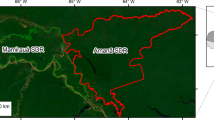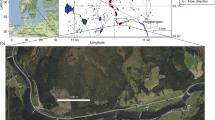Abstract
Fourteen samples of sago pondweed (Potamogeton pectinatus L.) and associated invertebrates were collected every two weeks over a single season of plant growth in a large monospecific pondweed-bed located in Coyote Hills Marsh (Alameda Co., California, USA), using pull-up samplers that collect plants, epiphytic macroinvertebrates, and microcrustaceans throughout the water column. The macro-invertebrate fauna was dominated by insects, primarily chironomids. Semi-aquatic neustonic taxa, including an aphid and a springtail, were common; this is in contrast with most aquatic plant-invertebrate studies, in which neustonic insects are seldom collected because of sampling bias. Over the entire season, P. pectinatus biomass and the densities of four insect taxa (Anopheles spp. mosquitoes, Hydrellia sp. brineflies, Ademon sp. parasitic wasps, and coenagrionid damselflies) were significantly correlated. These correlations resulted from both similar overall phenologies of the plant and each of the insect taxa, and ecological relationships in which P. pectinatus provides either a specialized habitat or food source. macroinvertebrate numbers were highest in mid-summer, when P. pectinatus forms a dense floating canopy; microcrustaceans were more common during plant senescence in early autumn. Individuals of some taxa may be distributed in proportion to plant biomass; this occurred commonly in damselflies, perhaps as a result of territoriality in these nymphs.
Similar content being viewed by others
References
Baker, R. L., 1980. Use of space in relation to feeding areas by zygopteran nymphs in captivity. Can. J. Zool. 58: 1060–1065.
Baker, R. L., 1987. Dispersal of larval damselflies: do larvae exhibit spacing behaviour in the field? J. n. am. benthol. Soc. 6: 35–45.
Balling, S. S. & V. H. Resh, 1984. Seasonal patterns of pondweed standing crop and Anopheles occidentalis densities in Coyote Hills Marsh. Proc. Calif. Mosq. Vector Control Assoc. 52: 122–125.
Berg, C. O., 1949. Limnological relations of insects to plants of the genus Potamogeton. Trans. am. microsc. Soc. 68: 279–291.
Berg, C. O., 1950. Hydrellia (Ephydridae) and some other acalyptrate Diptera reared from Potamogeton. Ann. ent. Soc. Am. 43: 374–398.
Biochino, A. A. & G. I. Biochino, 1980. Quantitative estimation of phytophilous invertebrates. Hydrobiol. J. 15: 74–76.
Bownik, L. J., 1970. The periphyton of the submerged macrophytes of Mikolajskie Lake. Ekol. pol. 18: 503–520.
Campbell, J. M. & W. J. Clark, 1983. Effects of microhabitat heterogenity on the spatial dispersion of small plant-associated invertebrates. Freshwat. Invert. Biol. 2: 180–185.
Cattaneo, A., 1983. Grazing on epiphytes. Limnol. Oceanogr. 28: 124–132.
Collins, J. N., E. P. McElravy, B. K. Orr & V. H. Resh, 1988. Preliminary observations on the effects of the intersection line upon predation of Anopheles mosquito larvae. Proc. int. Conf. biol. Control Vectors predaceous Arthropods 1: 1–12.
Collins, J. N. & V. H. Resh, 1985. Factors that limit the role of immature damselflies as natural mosquito control agents at Coyote Hills Marsh. Proc. Calif. Mosq. Vector Control Assoc. 53: 87–92.
Collins, J. N. & V. H. Resh, 1989. Guidelines for the ecological control of mosquitoes in non-tidal wetlands in the San Francisco Bay area. California Mosquito and Vector Control Association, Inc. & The University of California Mosquito Research Program, Sacramento, 93 pp.
Collins, J. N., S. S. Balling & V. H. Resh, 1983. The Coyote Hills Marsh model: Calibration of interactions among floating vegetation, waterfowl, invertebrate predators, alternate prey, and Anopheles mosquitoes. Proc. Calif. Mosq. Vector Control Assoc. 51: 69–73.
Convey, P., 1988. Competition for perches between larval damselflies: the influence of perch use on feeding efficiency, growth rate and predator avoidance. Freshwat. Biol. 19: 15–28.
Crowder, L. B. & W. E. Cooper, 1982. Habitat structural complexity and the interaction between bluegills and their prey. Ecology 63: 1802–1813.
Cummins, K. W., 1973. Trophic relations of aquatic insects. Ann. Rev. Ent. 18: 183–206.
Deonier, D. L., 1971. A systematic and ecological study of Nearctic Hydrellia (Diptera: Ephydridae). Smithson. Contr. Zool. 68: 1–147.
Dvorak, J. & E. P. H. Best, 1982. Macro-invertebrate communities associated with the macrophytes of Lake Vechten: structural and functional relationships. Hydrobiologia 95: 115–126.
Engel, S., 1988. The role and interactions of submersed macrophytes in a shallow Wisconsin lake. J. Freshwat. Ecol. 4: 329–341.
Feminella, J. W. & V. H. Resh, 1986. Effects of crayfish grazing on mosquito habitat at Coyote Hills Marsh. Proc. Calif. Mosq. Vector Control Assoc. 54: 101–104.
Feminella, J. W. & V. H. Resh, 1989. Submersed macrophytes and grazing crayfish: an experimental study of herbivory in a California freshwater marsh. Holarct. Ecol. 12: 1–8.
Frohne, W. C., 1939. Contribution to knowledge of the limnological role of the higher aquatic plants. Am. microsc. Soc. 57: 256–268.
Grigarick, A. A., 1959. Bionomics of the rice leaf miner, Hydrellia griseola (Fallen), in California (Diptera: Ephydridae). Hilgardia 29: 1–80.
Hargeby, A., 1990. Macrophyte associated invertebrates and the effect of habitat permanence. Oikos 57: 338–346.
Harrod, J. J., 1964. The distribution of invertebrates on submerged aquatic plants in a chalk stream. J. anim. Ecol. 33: 335–348.
Harvey, I. F. & P. S. Corbet, 1985. Territorial behavior of larvae enhances mating success of male dragonflies. Anim. Behav. 33: 561–565.
Higler, L. W. G., 1975. Analysis of the macrofauna-community on Stratiotes vegetations. Verh. int. ver. Limnol. 19: 2773–2777.
Iversen, T. M., J. Thorup, T. Hansen, J. Lodal & J. Olsen, 1985. Quantitative estimates and community structure of invertebrates in a macrophyte rich stream. Arch. Hydrobiol. 102: 291–301.
Krecker, F. H., 1939. A comparative study of the animal population of certain submerged aquatic plants. Ecology 20: 553–562.
Krull, J. N., 1970. Aquatic plant-macroinvertebrate associations and waterfowl. J. Wildl. Manag. 34: 707–718.
Lamberti, G. A. & V. H. Resh, 1984. Seasonal patterns of invertebrate predators and prey in Coyote Hills Marsh. Proc. Calif. Mosq. Vector Control Assoc. 52: 126–128.
McGaha, Y. J., 1952. The limnological relations of insects to certain aquatic flowering plants. Trans. am. microsc. Soc. 71: 355–381.
Macan, T. T., 1965. The fauna in the vegetation of a moorland fishpond. Arch. Hydrobiol. 61: 273–310.
Macan, T. T., 1977. The fauna in the vegetation of a moorland fishpond as revealed by different methods of collecting. Hydrobiologia 55: 3–15.
Maurer, M. A. & M. A. Brusven, 1983. Insect abundance and colonization rate in Fontinalis neo-mexicana (Bryophyta) in an Idaho Batholith stream, USA. Hydrobiologia 98: 9–15.
Menzie, C. A., 1980. The chironomid (Insecta: Diptera) and other fauna of a Myriophyllum spicatum L. plant bed in the lower Hudson River. Estuaries 3: 38–54.
Miller, P. L., 1987. Dragonflies. Cambridge Univ. Press, Cambridge, 84 pp.
Orr, B. K. & V. H. Resh, 1987. Interactions among mosquitofish (Gambusia affinis), sago pondweed (Potamogeton pectinatus), and the survivorship of Anopheles mosquito larvae. Proc. Calif. Mosq. Vector Control Assoc. 55: 94–97.
Orr, B. K. & V. H. Resh, 1989. Experimental test of the influence of aquatic macrophyte cover on the survival of Anopheles larvae. J. am. Mosq. Cont. Assoc. 5: 579–585.
Renn, C. E., 1942. Emergent vegetation, mechanical properties of the water surface, and distribution of Anopheles larvae. J. Nat. Malar. Soc. 2: 47–52.
Resh, V. H., J. W. Feminella & E. P. McElravy, 1990. Sampling aquatic insects. Videotape. Office of Media Services, University of California, Berkeley.
Rooke, J. B., 1984. The invertebrate fauna of four macrophytes in a lotic system. Freshwat. Biol. 14: 507–513.
Rooke, J. B., 1986. Seasonal aspects of the invertebrate fauna of three species of plants and rock surfaces in a small stream. Hydrobiologia 134: 81–87.
Rosine, W. N., 1955. The distribution of invertebrates on submerged aquatic plant surfaces in Muskee Lake, Colorado, Ecology 36: 308–314.
Smirnov, N. N., 1963. On inshore Cladocera of the Volga water reservoirs. Hydrobiologia 21: 166–176.
Smock, L. A. & D. L. Stoneburner, 1980. The response of macroinvertebrates to aquatic macrophyte decomposition. Oikos 35: 397–403.
Smyly, W. J. P., 1952. The Entomostraca of the weeds of a moorland pond. J. Ecol. 21: 1–11.
Smyly, W. J. P., 1957. Distribution and seasonal abundance of Entomostraca in moorland ponds near Windermere. Hydrobiologia 11: 59–72.
Soszka, G. J., 1975. Ecological relations between invertebrates and submerged macrophytes in the lake littoral. Ekol. pol. 23: 393–415.
Author information
Authors and Affiliations
Rights and permissions
About this article
Cite this article
Bergey, E.A., Balling, S.F., Collins, J.N. et al. Bionomics of invertebrates within an extensive Potamogeton pectinatus bed of a California marsh. Hydrobiologia 234, 15–24 (1992). https://doi.org/10.1007/BF00010775
Received:
Revised:
Accepted:
Issue Date:
DOI: https://doi.org/10.1007/BF00010775




